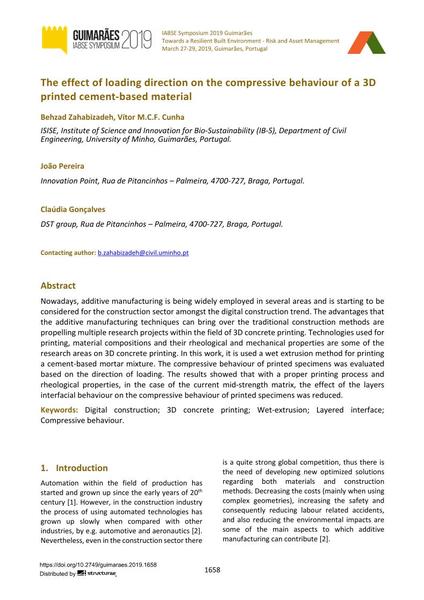The effect of loading direction on the compressive behaviour of a 3D printed cement-based material

|
|
|||||||||||
Détails bibliographiques
| Auteur(s): |
Behzad Zahabizadeh
(ISISE, Institute of Science and Innovation for Bio-Sustainability (IB-S), Department of Civil Engineering, University of Minho, Guimarães, Portugal.)
Vítor M. C. F. Cunha (ISISE, Institute of Science and Innovation for Bio-Sustainability (IB-S), Department of Civil Engineering, University of Minho, Guimarães, Portugal.) João Pereira (Innovation Point, Rua de Pitancinhos – Palmeira, 4700-727, Braga, Portugal.) Cláudia Gonçalves (DST group, Rua de Pitancinhos – Palmeira, 4700-727, Braga, Portugal.) |
||||
|---|---|---|---|---|---|
| Médium: | papier de conférence | ||||
| Langue(s): | anglais | ||||
| Conférence: | IABSE Symposium: Towards a Resilient Built Environment Risk and Asset Management, Guimarães, Portugal, 27-29 March 2019 | ||||
| Publié dans: | IABSE Symposium Guimarães 2019 | ||||
|
|||||
| Page(s): | 1658-1665 | ||||
| Nombre total de pages (du PDF): | 8 | ||||
| DOI: | 10.2749/guimaraes.2019.1658 | ||||
| Abstrait: |
Nowadays, additive manufacturing is being widely employed in several areas and is starting to be considered for the construction sector amongst the digital construction trend. The advantages that the additive manufacturing techniques can bring over the traditional construction methods are propelling multiple research projects within the field of 3D concrete printing. Technologies used for printing, material compositions and their rheological and mechanical properties are some of the research areas on 3D concrete printing. In this work, it is used a wet extrusion method for printing a cement-based mortar mixture. The compressive behaviour of printed specimens was evaluated based on the direction of loading. The results showed that with a proper printing process and rheological properties, in the case of the current mid-strength matrix, the effect of the layers interfacial behaviour on the compressive behaviour of printed specimens was reduced. |
||||
